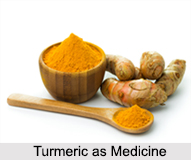 Turmeric plant, botanically known as Curcuma Longa is extensively cultivated for the sake of its tubers which are an essential ingredient of native curry powders. Turmeric pounded into a paste and mixed with oil, is rubbed on the skin to improve its appearance and prevent skin diseases. The rubbing of turmeric and oil is an essential part of the Hindu marriage festival as well as of some religious ceremonies.
Turmeric plant, botanically known as Curcuma Longa is extensively cultivated for the sake of its tubers which are an essential ingredient of native curry powders. Turmeric pounded into a paste and mixed with oil, is rubbed on the skin to improve its appearance and prevent skin diseases. The rubbing of turmeric and oil is an essential part of the Hindu marriage festival as well as of some religious ceremonies.
Benefits of Turmeric
Medicinally, turmeric is used chiefly in skin diseases both externally and internally. Turmeric paste with the addition of a little lime is a popular application to sprains and bruises. A decoction of turmeric is used as a cooling wash in ophthalmia; cloth steeped in it is employed as an eye-shade. A paste of turmeric and the leaves of Justicia Adhatoda (vasaka) with cow"s urine are rubbed on the skin in prurigo.
Dose of Turmeric in Medicine
Several other combinations of the sort are in vogue, such as turmeric and neem leaves, turmeric and the ashes of the plantain tree, etc. Turmeric is also given internally with cow"s urine in prurigo and eczema.
Haridrakhanda: Take turmeric 64 tolas, clarified butter 48 tolas, milk 16 seers, sugar 12 tolas, and boil them together over a gentle fire in an earthen pot. Then add black pepper, long pepper, ginger, cinnamon, cardamom, tejapatra, baberang seeds, root of Ipomcea Turpethum (trivrit), the three myrobalans, flowers of Mesua ferrea (nagakesara) tubers of Cyperus rotundus (mustaka) and prepared iron, each 8 tolas in fine powder, and prepare a confection. Dose of this should be 1 tola every morning in prurigo, boils, urticaria, etc. A cure is said to be effected in 7 days.
The term Haridradve, or the two turmerics, signifies turmeric and the wood of Berberis Asiatica. They are often used together in compound prescriptions both for external and internal use and their properties are said to be analogous.
This article is a stub. You can enrich by adding more information to it. Send your Write Up to content@indianetzone.com




















